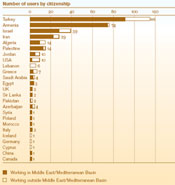SESAME
Can a recycled synchrotron become an oasis of peace in the Middle East?
By Mike Perricone
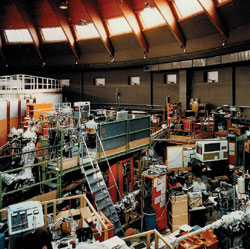 |
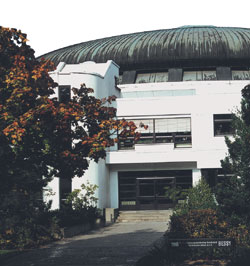 |
BESSY I, a 15-year-old, 0.8 GeV synchrotron accelerator, was destined to be designated as "junk." The field was demanding higher energies in 1997, and the Berlin Electron Storage Ring Company for Synchrotron Radiation was planning a new machine, seeking the lowest price to have the old and soon-to-be decommissioned ring hauled away for scrap.
Herman Winick learned of the plan in a September 1997 meeting of the BESSY II Machine Advisory Committee in Berlin, preparing for the successor machine. Winick and a friend and colleague of nearly 40 years, Gustav-Adolf "Gus" Voss of Deutsches Elektronen-Synchrotron (DESY) in Hamburg, believed the old machine had plenty of good science left in it: it had, after all, been a world-class facility in its time.
"Our top laboratories operate under budget strictures, yet we usually have the resources to obtain the newest and best equipment for upgrades to our facilities," says Winick, who is based at the Stanford Synchrotron Radiation Laboratory, California, but follows his research far and wide as scientists do. "Isn't it better to use that old equipment," Winick reasoned, "to recycle the surplus items, to put them in the hands of projects struggling for funds? Instead of just putting [the equipment] in a corner and forgetting it for 10 years?"
There had to be uses, somewhere, for the kinds of research applications that BESSY I had successfully performed since 1982. Synchrotron accelerators use magnets to create a circular path for electrons traveling at nearly the speed of light, producing a beam of bright ultraviolet and X-ray light, about the diameter of a human hair, that is directed down beamlines to experiment end stations. Synchrotron radiation is widely used in materials science and biomedical applications, including lithography for computer chips; absorption and scattering measurements; high-pressure applications to create artificial diamonds and other substances; and protein crystallography (the double-helical structure of DNA was established through X-ray diffraction patterns).
Other synchrotrons were offering higher energies for more demanding work. But Winick and Voss believed that, beyond first-in-the-field science capabilities, BESSY I could also serve a higher calling in a region wanting for scientific development, perhaps the Middle East. A destination presented itself just a few months later, when Voss met several Middle Eastern scientists at a conference organized by Sergio Fubino and others in Torino, Italy. Fubino, a prominent theoretical physicist from CERN, had been a founder of the Middle East Science Committee (MESC). The conference theme focused on seeking ways to support science in the Middle East, and the idea of donating the BESSY I synchrotron took a strong and immediate hold.
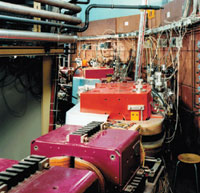 The BESSY I synchrotron-light source (above and top of page) was originally operated at the Berlin Electron Storage Ring Company for Synchrotron Radiation (second photo from top). Now the old apparatus is awaiting its new site in Jordan, providing useful science—and, hopefully, an oasis of peace for the Middle East. (Images courtesy of BESSY.) |
"When Gus mentioned the possibility, he got a very positive response," Winick recalls. "He wrote to me, we fleshed out some details, and he contacted some people in the German government. Gus had good connections in Germany."
Winick, Voss and many others began the process that nurtured the recycling of BESSY I into the International Centre for Synchrotron-light for Experimental Science and Applications for the Middle East (SESAME), now under construction at Al-Balqa' Applied University in Jordan. Can the re-engineered synchrotron also serve as an agent for change in the Middle East? With the partnership of the United Nations Educational, Scientific and Cultural Organization (UNESCO), SESAME's goals intertwine the furthering of science and the nurturing of connections among scientists from throughout the Middle East and beyond. "I consider the UNESCO slogan 'science for peace' to be as important an objective for SESAME as the science and training aspects," says Herwig Schopper, President of the SESAME Council and former Director-General of CERN, the European Particle Physics Laboratory in Geneva, Switzerland. "Indeed, this was one of the main motivations for establishing SESAME, to contribute to a better understanding among people of different traditions, religions and political systems."
A tent near the Red Sea
The idea of using science for peace in the Middle East had been forming in many minds, and the connections were waiting to be made. At CERN, Fubino and Israeli physicist Eliezer Rabinovici were active advocates for MESC, which had been seeking opportunities for Israeli and Arab scientists to work together. Rabinovici, a string theorist and now a member of the SESAME Council for Israel, recalled an especially poignant meeting in 1995, hosted by the Egyptian government near the Red Sea resort of Dahab. In attendance were scientists from throughout the Middle East—Israel, Egypt, Jordan, Morocco, and the Palestinian Authority—and from Europe and the United States, including physicists Ed Witten and Nathan Seiberg of the Institute for Advanced Study at Princeton University, and Robert Laughlin of Stanford (who would win the 1998 Nobel Prize in physics).
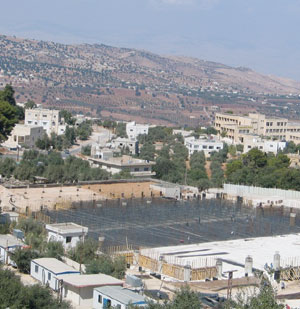 The International Centre for Synchrotron-light for Experimental Science and Applications for the Middle East (SESAME) is now under construction at Al-Balqa' Applied University in Al-Salt City, Jordan. Al-Balqa' Applied University, founded in 1997, offers Bachelor and Associate degrees for more than 21,000 students. Fields of study are Applied Sciences; Engineering; Technological Agriculture; Planning Management; Graduate Studies and Scientific Research; and a Traditional Islamic Arts Institute. The university also has oversight for 19 community colleges in the region. (Image courtesy of SESAME.) |
"There had been an earthquake in the area, measuring 7 on the Richter scale, and we were meeting in a Bedouin tent," recalls Rabinovici, of Racah Institute of Physics at Hebrew University in Jerusalem. "There was another significant event—[Israeli Prime Minister] Yitzhak Rabin had been murdered several weeks before the meeting. The Minister of Science of Egypt, Venice Gouda, asked everyone to stand and honor Rabin. We all stood; people from Al Azhar University in Cairo, people from Israel, people from Jordan—it was very touching... It gave us hope for 'little' science, that scientists from Arab countries felt comfortable cooperating in this situation. By 'little' science, I mean scientists meeting and working at a one-to-one level. It was an outstanding meeting, and we continued our efforts."
Those continued efforts encompassed the Torino meeting, after which Rabinovici and Fubino elicited the interest of Schopper, the CERN Director-General from 1980 to 1988. At a 1998 MESC meeting in Uppsala, Sweden, Winick and Voss presented their proposal for recycling BESSY I as the basis for a synchrotron-light source laboratory in the Middle East. Voss and Schopper worked to confirm an agreement with the German government for donating the machine. Schopper contacted Federico Mayor, then-Director of UNESCO, who followed up by calling a consultative meeting in Paris in June 1999 with 12 prospective Middle East members attending. Voss and Winick again made their presentation, and UNESCO formed an Interim Council to launch the proposed synchrotron-light source center.
Efforts were also evolving among Palestinian scientists. Said Assaf, Director-General of the Palestinian Authority's Arafat National Scientific Center for Applied Research in Ramallah, West Bank, was invited to a 1998 seminar at Israel's Weizmann Institute of Science where he learned of the synchrotron center proposal. Assaf initiated a meeting for himself, Schopper and Maurizio Iaccarino, UNESCO Director-General of Science, with Palestinian Authority Chairman Yasser Arafat. Assaf reported that Arafat (who has a degree in engineering from Egypt's King Fahd University) was enthusiastic about the project and offered "strong recommendations to host SESAME in the Palestinian Authority area." Assaf, who received his PhD in biophysics and biochemistry from Iowa State University, recalled that it was he and Winick who formulated the SESAME acronym. Assaf also pressed for—and won—the endorsement for a SESAME satellite center, the Middle East Life Sciences Institute for Research (MELSIR), located in Palestinian territory.
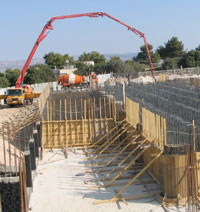 Groundbreaking took place on January 6, 2003 for construction of the SESAME site at Al-Balqa' Applied University. The collaboration hopes to have the new synchrotron facility in operation in 2009. (Image courtesy of SESAME.) |
Schopper was named chair of the Interim Council. He retained the chair when the Permanent Council was formed in 2003. In April 2004, SESAME was formally established as an autonomous intergovernmental organization following the model of CERN. At least six members had to accept the statutes by a letter from the head of state or foreign minister. If a state wants to join SESAME, a letter must be sent to the Director-General of UNESCO. The current members are Bahrain, Egypt, Iran, Israel, Jordan, Pakistan, the Palestinian Authority, and Turkey; some others (for example, the United Arab Emirates and Oman) are still involved in legal procedures requiring signatures at the head-of-state level; Greece, Germany, Italy, Japan, the United States, the United Kingdom, Kuwait and Libya are observers, with the participation of others under discussion.
The UNESCO umbrella had been used in much the same way in the years following World War II to bring together two initiatives: one originating from physicists, the other pushed by politicians to use science as a pathway for regional cooperation and cohesion in Europe. That early "science for peace" effort built the European Particle Physics Laboratory in Geneva, Switzerland—CERN. Schopper states that the Council originally created by UNESCO for the project retains a symbolic presence in the "C" in CERN, which is still governed by a Council with ultimate authority in all scientific, technical and administrative matters.
Exchange of ideas
There are some 45 synchrotron facilities around the world. SESAME, which hopes to begin operations in 2009, is not specifically aimed at competing with any or all of them, though it might enjoy a local advantage. In the region that gave birth to civilization, archeology offers an intriguing new application for SESAME: synchrotron light can be used to study concentrations of metals and other elements as evidence of ancient environments and environmental change. Yet SESAME hopes for a broader reach.
"Establishing a cutting-edge synchrotron in the Middle East, where none exists, advances scientific research in this region in the many fields where synchrotron radiation is used," says Moshe Deutsch of Israel's Bar-Ilan University, a synchrotron user for nearly 25 years, chair of the National Synchrotron Committee of Israel's National Academy of Sciences and Humanities, and member of the SESAME Council. "The easy access provided by a nearby facility will add greatly to the ability to do cutting-edge research in all the countries in the region. Moreover, as a central meeting point for researchers for a number of countries, it will provide opportunities for an exchange of ideas."
When operations begin, the annual budget is anticipated at about US$4 million; the current $660,000 annual budget is achieved through assessments on members. UNESCO has contributed about $700,000, in addition to its organizational oversight; the US Department of Energy has contributed some $500,000. The United States is an "observer" in SESAME, but not a member, and the US representative to UNESCO has attended several SESAME Council meetings. Germany's contribution of BESSY I, largely the injector components of the machine, is hard to assess in dollars but would certainly total several millions. Stanford Linear Accelerator Center (SLAC), in California, and Laboratoire pour l'Utilisation du Rayonnement Electromagnétique (LURE), in France, have also donated several million dollars worth of equipment. Pakistan will take the lead in constructing one beamline; six beamlines are planned, ranging from hard (high-energy) X-rays to the infrared range. Schopper said SESAME is hoping for some 10 million from the European Community for the upgrading of the machine, with the possibility of additional funding from the United States. The project also hopes for funding from the International Atomic Energy Agency (IAEA) in Vienna for training and beamlines.
"The injectors from BESSY I are sitting in Jordan now, in a warehouse northeast of Amman," Winick says. "We have 100 pallets of magnets and power supplies. As soon as the building is ready, we can start moving in the injectors and work on buying ring components."
The new ring will have a circumference of 116 meters; the original BESSY I ring was 62 meters. Upgrades will be directed by Dieter Einfeld and SESAME Technical Director Gaetano Vignola. Jordan's contribution of land and infrastructure is hard to estimate, but the construction of the building alone is worth some $8-10 million. The site was selected by a vote of the Council among the seven bidders submitting proposals: Armenia, Egypt, Iran, Jordan, Oman, the Palestinian Authority and Turkey. Jordan's Al-Balqa' Applied University, founded in 1997, has more than 21,000 students and is the hub for 19 community colleges in the area. Ground was broken in June 2003 with construction beginning that fall and completion slated for summer 2005.
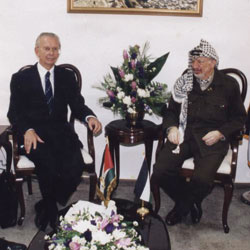 Herwig Schopper (left), Chairman of the SESAME Council, meets with Yasser Arafat, President of the Palestinian National Authority. Also at the 1998 meeting was Maurizio Iaccarino, then Director-General of Science for UNESCO. (Image courtesy of Said Assaf.) |
"Parallel universe"
Open access was a critical requirement for hosting SESAME. Schopper noted that a host state agreement was signed giving SESAME the same level of diplomatic privileges as those enjoyed at CERN. With the enthusiastic backing of King Abdullah II and his Education Minister, Professor Khaled Toukan, for the project, Jordan gave its guarantee of open access, and Schopper stated that there have been no visa problems over the last three years, "except when people sometimes applied too late. Even security problems could be solved in all cases."
Among Council members and collaborators, the descriptions of the working relationships portray an environment that is generally positive despite the net of tensions constraining the region. To be sure, there are undercurrents, though not always the expected ones.
"The Palestinian role is certainly important from the political point of view," says Council member Salman M. Salman of A-Najah National University in Nablus, West Bank, who served on the site selection committee and is a longstanding member of the technical committee. "But we also like to see equal appreciation of the Palestinian participation on the scientific level. Sometimes we feel we are not given that recognition. Sometimes we feel our role is directed as a front for the sealing of the political part, that the Palestinian political cause is used to pursue projects and activities that do not give [Palestinians] proportional weight in the benefits or responsibilities. We have a lot of experience using our cause for the benefit of other causes. We do not mind using that for others, but we expect to get our own benefits, too."
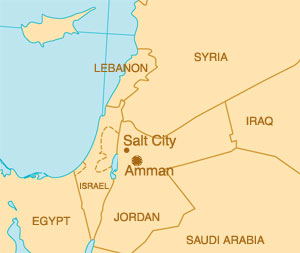 |
Salman, a high-energy physicist who has collaborated at Fermilab, Brookhaven and CESR at Cornell, says the Palestinians do have some concerns about free access, but he also notes: "However, we do not see pre-set minds concerning the Palestinian role with SESAME."
Schopper emphasizes the importance of international collaboration extending to "administrators and politicians up to the highest levels," which came into play with some intensity during meetings at the diplomatic levels to discuss how the Palestinian Authority should be referred to officially in the statutes of the project. At the collaboration level, Rabinovici notes that many members have begun to assume leadership roles; the October 2004 users meeting in Antalya, Turkey, was organized and chaired by Sehra Zayers of Turkey, and Samar Hasnain of Pakistan and the United Kingdom. Scientists themselves report their interactions to be cooperative and convivial, sometimes surprisingly so.
"My experience of SESAME is one of living in a parallel universe," says Rabinovici. "It's been so amazing from the beginning. We live in a political world, with many oscillations, good days and bad days. It is the same with the Arabs. They have good days and tough days. Yet I've never felt that inside the meeting room. There, we were scientists working for a common goal, building this accelerator for the benefit of everyone in the area… It's a model of how our universe could have been. It gives me some optimism, sometimes in a period when it is not so easy to hold onto optimism."
Deutsch has observed the rituals of daily life softening the pressures of politics: dinner defusing differences.
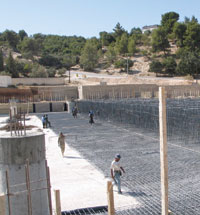 Jordan's donation of land and infrastructure for SESAME is valued at $8-10 million. The Council hopes to being operating the synchrotron-light source in 2009. (Image courtesy of SESAME.) |
"The relations with our Palestinian counterparts are friendly and good," Deutsch says. "So much so that on occasions, we even dare approach political issues, very carefully, very cautiously, never going past the point where the discussion may turn too heated. Knowing the land, the towns, the people, the politics, the food of each other from first-hand experience helps in some cases to understand better each other. If nothing more, we can make common jokes on some of the political figures in the region, which would not be understood by someone from further away."
Still, the scientists understand that their SESAME experience cannot be insulated from their larger world. In fact, the stakes will be raised by increasing numbers of scientists and students with more frequent comings and goings when SESAME becomes an active research facility. The parallel universe would merge with reality.
"In the present situation," says Deutsch, referring to the state of violence, "no Israeli—or American or British—[researcher] would dare to cross the West Bank to Jordan, travel through Jordan, and stay there two weeks to do research. Restoration of at least a measure of normality to everyday life is an absolute necessity for the well-being and progress of SESAME. We all hope and pray that this will come soon."
Those same hopes and prayers live in both Israelis and Palestinians. "If peace cannot be established with justice to all," says Salman, "the contribution of the project will suffer."
Science for peace will also need peace for science.
Click here to download the pdf version of this article.



